 Keys... Keys...
 Appendices... Appendices...
|
 |
|
Configuring Your Telephone
Once you have verified that your telephone is connected to the network (see the
section, Verifying the Installation), you need to configure it. You also may need to
modify the configuration from time to time. There are two ways to do this. You can
access the website on the telephone's built-in web server using a web
browser on a computer that is on the same network as your telephone, or you can use
the menu which is accessible on the telephone itself.
Website
There are several areas to configure on the website, all reachable through links on the
main page at http://<network address>/, where <network address> is the network
address of your telephone, e.g., 10.0.0.167. You can determine what this address is by
pressing MENU/BACK. The address is displayed momentarily on the second line
of the LCD.
From the main page (where your telephone version and serial number are
displayed), you can follow links to pages for
- network setup,
- telephone configuration,
- server configuration,
- maintaining memory keys and phonebook,
- setting the administrator and user passwords for accessing your telephone's
website and menu,
- advanced settings, and
- updating the software in your telephone.
 WARNING: Never change
the configuration of your telephone during a call. WARNING: Never change
the configuration of your telephone during a call.
When you first attempt to access the website, you are prompted for a user
name and password. There are two access levels, administrator and user, and
two corresponding user names, "admin" and "user" (without the quotes). The
initial password for both is set at the factory to "1234" (also without the
quotes). You should change the passwords as soon as possible. When you log in
as user, you have access to the general-information, telephone-configuration,
memory-key-and-phonebook, and password pages. When you log in as administrator,
you have access to those pages and to the network-setup, servers, advanced, and
upgrade pages. The following table identifes the attributes of each access level.
| Access Level | User Name | Default Password | General | Network Setup | Phone Configuration | Servers | MEM Keys & Phonebook | Change Password | Advanced | Upgrade
|
|---|
| Administrator | admin | 1234 | Yes | Yes | Yes | Yes | Yes | Yes | Yes | Yes
| | User | user | 1234 | Yes | No | Yes | No | Yes | Yes | No | No
|
Network Setup
This page contains network and Quality-of-Service, or QoS, settings.
The main network setting on this page is whether DHCP is selected. The
choices are DHCP (the factory default) and MANUAL. Your service provider or
network administrator can tell you which one to use. If DHCP is selected, no
further network configuration is required—your telephone retrieves
the network configuration from a DHCP server—and your page looks something
like this:
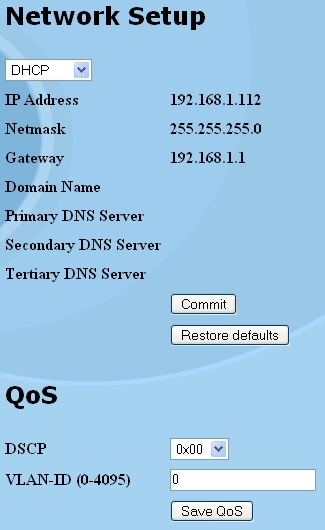
If DHCP is not selected, your page looks something like this:
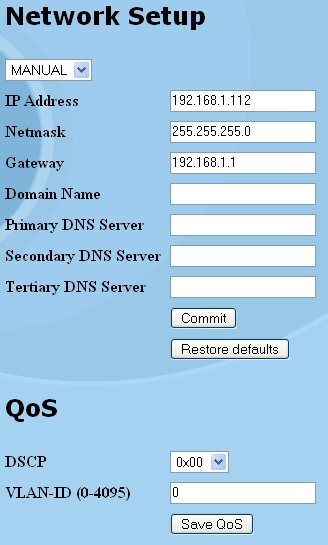
These network-settings fields have the same meaning as the network
settings for other network devices and operating systems. The values for these
fields are supplied by your service provider or network administrator.
Make any changes you need to the network settings and then click the button
to commit your changes. Your changes only take effect when you commit and
then confirm them. There is also a button that you can click to restore the
factory defaults.
The QoS settings are independent of the network settings.
- The Differentiated Sevices Code Point, or DSCP, tells the network
how to handle the data packets transmitted by your telephone—what the
performance requirements are with regard to, for example, delay, loss, and jitter.
The normal setting for VoIP is 0x2e.
- The VLAN ID identifies the VLAN on which your telephone resides.
If you are unfamiliar with VLANs, just set this to 0. Note that when your
telephone is on a VLAN—the VLAN ID is set to something other than
0—all devices connected through your telephone's PC network port must also
be on a VLAN, which could be the same as or different from your telephone's VLAN.
Make any changes you need to the QoS settings and then click the button to
save your changes. Your changes only take effect when you save them.
Telephone Configuration
The telephone-configuration page contains basic settings and features that
a user initially sets up and might want to change from time to time, such as
his or her name and whether to block Caller ID. Your page looks something like
this:
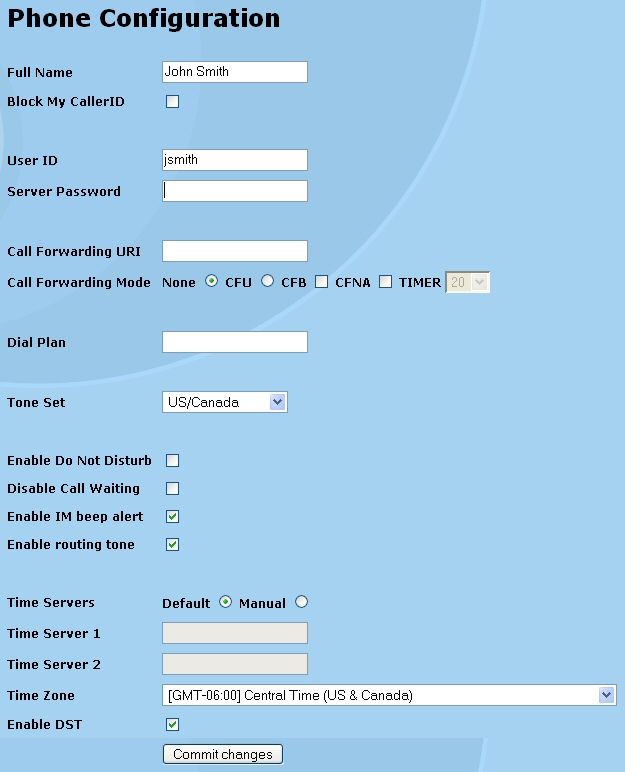
- Unless blocked, the name is reported as your Caller ID to the other party.
- The block-my-caller-id field prevents your Caller ID from being shown to
the other party. This only occurs, however, when your telephone is configured to
use a proxy server, because the server strips out the Caller ID. Without a
server, your Caller ID cannot be blocked, and so the other party can always see
it.
- The user identifier and optional server password are used for server access.
The user identifier might be a nickname such as jsmith or a
service-provider-assigned telephone number such as 5550123. Spaces are not
allowed in the user identifier. Your network administrator or service provider
will tell you what to use for these fields.
- The forwarding-address field contains the network address or SIP URI of the
telephone to which you want to forward incoming calls. Leave it blank or specify
no call forwarding if you do not want to forward calls. Select whether you wish
to forward all calls, forward calls when your telephone is busy, or forward
calls if you do not answer after the selected number of seconds.
- So that you do not have to indicate to your telephone when you have finished
entering a telephone number by pressing the DIAL softkey or DIAL/REDIAL
(although you may continue to do so), you may provide a dial plan of up to 128
characters (see the Dial Plan appendix) which tells your telephone what
a telephone number "looks like." Once your telephone recognizes a complete
telephone number, it automatically places the call.
- You may select which set of tones your telephone uses based on your
regional preference.
- When the Do Not Disturb feature is enabled, your telephone does not ring
or otherwise indicate when it receives an incoming call.
- Call Waiting can be disabled so that your telephone immediately rejects an
incoming call if there is already an active call.
- You can control whether your telephone beeps when it receives an IM and
whether a routing tone is played for the brief interval between placing a call
and the remote end starts ringing.
- Your telephone contacts a time server to determine what time and
date it is. There are three ways it determines what servers to contact.
- First, it uses the time servers whose addresses, if present, are returned
by the DHCP server if your telephone is configured to obtain its network
configuration from a DHCP server.
- If that is unsuccessful and your telephone is configured to use the
Default servers, it uses the defaults of 1.pool.ntp.org and
2.pool.ntp.org.
- Otherwise, it uses the time servers you have specified via the
Manual alternative.
Your telephone attempts to contact a time server when
- it boots,
- you select the Default time-server mode,
- you select the Manual time-server mode,
- you change a time server while in Manual mode, and
- you press the TIME softkey.
- Select your time zone and whether daylight savings time is
observed so that your telephone knows how to adjust the information it gets
from the time server for your specific locale.
Make any changes you need on this page and then click the button to commit
them. Your changes only take effect when you commit them.
Servers
The server page requires some familiarity with SIP. Use it to specify a SIP
registrar, proxy, conference server, voicemail server, and related
parameters, but first contact your network administrator or service provider
for the correct settings.
If you instruct your telephone not to perform registrations at all, your
page looks something like this:
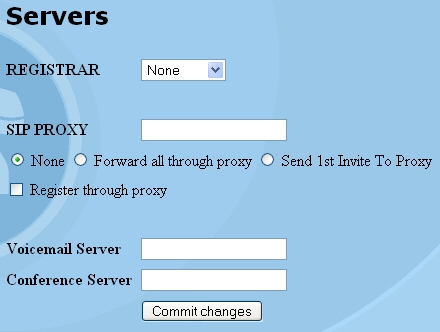
If you instruct your telephone to attempt to find a registrar and register on
its own, your page looks something like this:
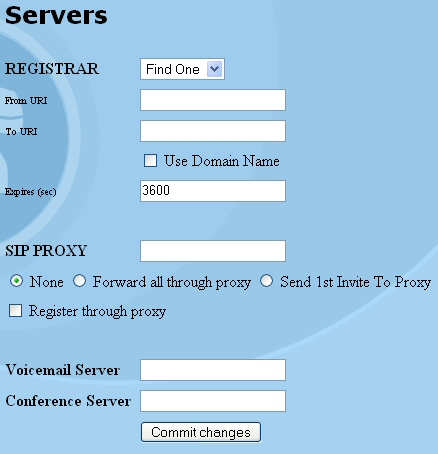
It is best to use a SIP URI to explicitly designate the registrar.
A simple network address, e.g. 10.0.0.200, is also allowed. If you specify the
registrar, your page looks something like this:
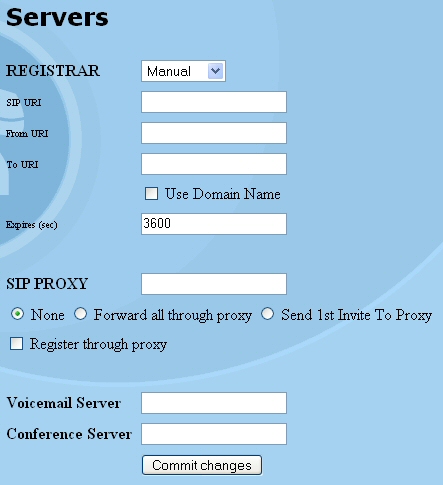
- The to-address field contains the address of record whose registration is to
be created or updated, i.e., how you want the outside world to see you from your
SIP proxy/registrar, as in sip:user@example.com, where a proxy server for the
example.com domain forwards SIP messages to you after receiving the above SIP URI
from other parties. Note that, to enable keypad dialing, you must specify a
registrar or proxy. If both are specified, the proxy has precedence.
- The from-address field is the same as the to-address field except in the
case of third-party registrations on your behalf.
- The expire-time field specifies the registration duration as reported to the
registrar in units of seconds. The default is 3600 seconds, or one hour.
- If you are using a registrar and select the use-domain-name feature, your telephone
automatically creates the addresses of record in the to-address and from-address
fields. It combines the user identifier that you specified on the
telephone-configuration page with the local domain name obtained from DHCP or
manual configuration (refer to the network-setup page for your domain name).
Note that you can change the addresses of record at any time, even if they were
generated automatically.
- Specifying a value for the proxy field causes your telephone to send
various SIP messages through the outbound proxy indicated by the specified
address or SIP URI; otherwise, it sends all SIP messages except SIP
registrations directly to the remote end.
- If a proxy is specified and the forward-all-through-proxy feature is
selected, all SIP non-registration messages are sent through the proxy;
- if a proxy is specified and the send-1st-invite-to-proxy feature is
selected, only the first invitation is sent through the proxy, which is useful
when the phone is used with a redirect server;
- if neither of these features are selected, only dialed numbers and
unresolved URIs go through the proxy.
- If a proxy is specified and the register-through-proxy feature is
selected, SIP registration messages are sent through the proxy.
A SIP proxy is useful for traversing firewalls, assuming your proxy can rewrite
addresses, and handling unresolvable SIP URIs, such as telephone numbers. When both a
SIP registrar and proxy are specified, you can have your telephone register directly
with the registrar rather than through the proxy.
- To use a voicemail server, specify its address in the voicemail-server field.
- To use an external conference server rather than the built-in conferencing capabilities
of your telephone, specify the server's address in the conference-server field.
Your changes only take effect when you commit them.
Memory Keys and Phonebook Maintenance
This page is used to set and maintain the speed-dial memory keys and the phonebook.
The page looks something like this:

For each memory key, fill in the nickname (no spaces) and SIP URI, such as
SethJones sip:192.168.1.100
and then click the save button. The "sip:" is optional—your
telephone automatically prepends it if missing.
The phonebook is a little different than the rest of the website. Elsewhere,
you maintain a few fields; with the phonebook, you maintain a list of
SIP URIs along with nicknames for the people associated with them.
- To add an entry to the phonebook, fill in a nickname (no spaces) and SIP
URI, such as
pancho_h sip:+14085550100@172.16.0.222
and then click the add button, which commits your addition. The "sip:" is
optional—your telephone automatically prepends it if missing.
- To delete entries, select one or more, and then click the delete button,
which commits your deletion.
- To change entries, you must delete and then add them again.
- Alternatively, from this page you can load a phonebook from your PC as a
text file that you created through some other means. Importing a phonebook
commits the additions to your telephone. Note that importing is additive. It
does not replace your existing phonebook even if entries have the same name. A
line that starts with the # character is ignored as a comment line. The space
and tab characters can appear anywhere except within a nickname or URI.
- You can also save the phonebook to your PC as a text file. This text file
contains any number of phonebook entries, each on a separate line made up of a
nickname and SIP URI.
Whenever entries are added to the phonebook, either through the website or by
importing a phonebook from your PC, there is the possibility that one or more
entries will have the same nickname. Your telephone resolves this conflict by
appending a number to nicknames as needed to make them unique. For example, if
the phonebook on your telephone already contained an entry with the nickname,
pancho_h, and the user imported a phonebook from a PC that contained an entry
with the same name, the second entry would be named pancho_h2 in the telephone
phonebook.
Password Configuration
This is the page where you specify the admin and user passwords that grant
access to your telephone's website and menu. To change a password, select the
one you want to change, specify the current password and the new password you
would like to use. Enter the new password a second time to help prevent
establishing a password with an unknown typographical error. Once you enter the
current password and the new password twice, click the button to commit your
change. Your changes only take effect when you commit them. If you forget
your password, there are several ways you can restore the factory default
(see the section, Troubleshooting). The password-configuration page looks like this:
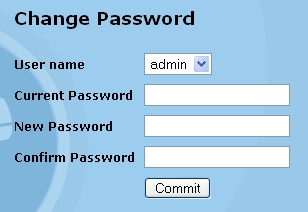
Advanced Settings
Like the server page, the advanced-settings page requires familiarity with SIP. Here,
you can specify, for example, the default SIP port for your telephone, a syslog server, autodial
parameters, keepalive settings, your preferred codec, and whether to use preloaded
route. However, you should only use these fields if you
have extraordinary needs and a full understanding of their meaning.

- The default SIP and RTP ports, which are normally 5060 and 5012, respectively, are
the ports at which you wish other parties to contact you. Note that the RTCP port is not
specified because it always is the RTP port + 1.
- If you have a NAT/firewall that you want to traverse, specify its WAN, or outside, IP
address. You also need to configure rules in your NAT/Firewall to forward incoming SIP,
RTP, and RTCP UDP packets to the ports on your telephone, e.g., 5060, 5012, and 5013.
Multiple phones behind the same NAT may be configured with different sets of ports. (If
you use a proxy server, it must support ports in addition to the default ports.) For
example, if you have two telephones, you could configure one to use SIP port 5060 and
RTP port 5012 and the other to use SIP port 5070 and RTP port 5022. You would then
need to configure your NAT/firewall to forward all incoming UDP packets for ports 5060,
5012, and 5013 to be forwarded to the IP address of your first telephone and forward all
incoming UDP packets for 5070, 5022 and 5023 to be forwarded to the IP address of your
second telephone.
- You can specify a syslog server for the logging of SIP messages received from and sent
to your telephone. Setting up a syslog server is beyond the scope of this document.
Leave the syslog-server field blank if you do not understand what a syslog server is,
effectively disabling the syslog feature.
- The autodial fields are for connecting to the remote proxy without dialtone or ringing.
- When the session-timer feature is enabled, your telephone uses a keepalive
mechanism in order to better detect whether a call has been disconnected.
- If you have a preference, you can influence which audio codec your telephone uses
by specifying a preferred codec.
- The preloaded-route feature adds a SIP "Route:" header in outgoing messages to
request that the outbound proxy be included in all return paths. This is ideal for firewall
traversal for those SIP proxies that support this feature.
- Rather than configure your telephone from the website or menu, you can
alternatively download configuration files from a TFTP or HTTP server (see the
Auto-configuration appendix for details). The configuration-server-type field
specifies which protocol to use to download the files. If you select HTTP and
access the HTTP server through a proxy, you can specify the proxy address
and port number. The configuration-server-address field contains the
address of the server from which your telephone downloads configurations
and a dial plan via its optional auto-configuration feature. Note that this is not where the
address is specified of the file server from which your telephone downloads software
upgrades (see the appendix, Updating the Software). The only profile type currently
supported is that described in the Auto-configuration appendix (Profile-C), so set the
auto-config-profile field to NONE to further disable auto-configuration and to Profile-C to enable it.
The auto-config-path field specifies the path, relative to the server's starting directory,
from which your telephone downloads the configuration file (this is also used for
downloading a dial plan). You can also force your telephone to load the configuration file
every time it boots by checking the auto-config-every-boot field; otherwise, it loads the
file just when you click the commit button on this page.
- If you would rather download a dial plan from a server rather than specify it on
the telephone-configuration page, store the dial plan in a file in the same directory as
the auto-configuration" configuration files on your server. Name the file, "dialplan.conf."
Note that the auto-configuration path also applies to the dial-plan file and that the dial plan is
downloaded from the server specified on the servers page.
- Disabling feature codes causes your telephone to not process and to instead
pass through all key presses for "star" feature codes, e.g., *67, *69, *70, and
*99, for downstream processing.
- Disabling CALL 1/2 during calls allows for other methods of getting a second dial tone.
For example, disabling CALL 1/2 and selecting RFC 2833 as the transmit-DTMF method causes the phone to
simply transmit the RFC 2833 "flash" event instead of processing this key press internally.
- You can specify to only use UDP SRV search in order to limit the means of DNS name
resolution.
- Select the method that you would like your telephone to use to transmit DTMF—keypad
presses—during a call. The choices are
- the INFO method as defined in IETF RFC 2976,
- injected into the RTP stream as defined in IETF RFC 2833
(if the remote end does not support, in-band is used), and
- in-band as audio.
- Headset support must be enabled here for your headset to work. Simply
plugging a headset into your telephone is not enough to make it work.
- If you would like your telephone to automatically go offhook when it
receives a third-party REFER message, enable it here. This is for
situations where the user initiates a call from a third-party device, such as a
PC-based softphone or click-to-talk feature, but then wants your telephone to
go offhook and actually place the call.
Make any changes you need on this page and then click the button to commit
them. Your changes only take effect when you commit them.
There is also a button that you can click to restore the factory defaults.
Upgrade
See the section, Updating the Software.
Menu
You enter the menu by pressing MENU/BACK while your telephone is idle. From
here, you can update the software in your telephone, view call logs,
read and write IMs, set up call forwarding, configure and reset your telephone,
and configure its memory keys. Please refer to the following Navigation
Map for detailed information on how to navigate the menu.
Data-entry Modes
There are two modes in the menu for entering data from the keypad. The
mode is automatically determined based on the type of data that your telephone is
expecting. When your telephone is expecting input only in the form of a network
address, the network-address mode is used and 123 is displayed in
the LCD; when expecting text such as a SIP URI or nickname, the alphanumeric
mode is used (see table, below). The alphanumeric submode is indicated by the
123, abc, or ABC softkey label in the
LCD.
| Key
| Network- address Mode
| Alphanumeric Mode
|
| 123 | abc | ABC
|
| Numeric | Lower-case | Upper-case
| | 1 | 1 | 1 | <space> | <space>
| | 2 | 2 | 2 | a b c | A B C
| | 3 | 3 | 3 | d e f | D E F
| | 4 | 4 | 4 | g h I | G H I
| | 5 | 5 | 5 | j k l | J K L
| | 6 | 6 | 6 | m n o | M N O
| | 7 | 7 | 7 | p q r s | P Q R S
| | 8 | 8 | 8 | t u v | T U V
| | 9 | 9 | 9 | w x y z | W X Y Z
| | 0 | 0 | 0 | . @ _ | + =
| | * | . | . | * [ < | , $ &
| | # | . | # | : ] > | ; ? /
|
In network-address mode, the keys, 0 through 9, map to
themselves, and * and # map to a period. This is sufficient for entering normal,
IPv4 network addresses.
In alphanumeric mode, what a key maps to is determined by the current submode,
which can be numeric, lower-case alphabetic, or upper-case alphabetic. This is
indicated by the submode indicator described above. You cycle to the next
submode by pressing the 123/abc/ABC softkey. In numeric submode, the keys, 0
through 9 and #, map to themselves, and * maps to a period. In the alphabetic
submodes, 1 maps to a space character, 2 through 9 map to a letter, and 0, *,
and # map to a punctuation character. For keys that map to a letter or
punctuation, you select a particular character by repeatedly pressing the key
until the character you want is displayed. A vertical-line cursor indicates
that you can continue pressing the same key to select a character for the
current cursor position. If you wait more than two seconds, the cursor changes
to a solid block, which indicates that your telephone has accepted the
currently selected character and is ready for you to select a character for the
next position. If you press another key on the keypad within two seconds, the
currently selected character is accepted and your telephone is ready for you to
select a character for the next position.
For both modes, pressing the ENTER or SAVE softkey saves the currently
displayed value and terminates data entry, and pressing the DEL softkey acts as
a backspace key by removing the right-most character from the LCD.
Menu Navigation
- You enter the menu structure at the top by pressing MENU/BACK when your
telephone is idle.
- Possible softkey choices (and their resulting displays) for a display are
all indented one level, below the display.
- Pressing MENU/BACK backs up one menu level, to the first outdented display
above.
- Upon leaving the bottom of a submenu (no display, indented below it), your
telephone typically exits the menu and returns to the
Ready
display or the next submenu is straightforward and there is no point in
describing it here.
- Going offhook momentarily completely exits the menus. You can do this by either
briefly lifting the handset off the cradle or pressing SPEAKER/HEADSET twice.
| John Smith
| | 192.168.1.111
| | Serial #KT20A2000865
| |
| | SipTone(TM) III 1.3.0
| | build 105
| | ______________________
| | UPGRD LOGS IM SETUP
|
Copyright © ipDialog, Inc. 2002-2006 All rights reserved.
|


 Quick Reference Guide
Quick Reference Guide
 Overview...
Overview...
 Installation...
Installation...
 Configuration...
Configuration...
 Layout
Layout
 Display Examples
Display Examples
 Keys...
Keys...
 Basic Operation
Basic Operation
 Maintenance
Maintenance
 Appendices...
Appendices...
 Glossary
Glossary








